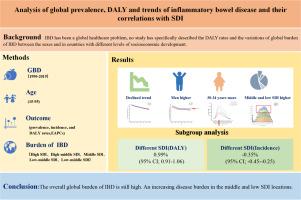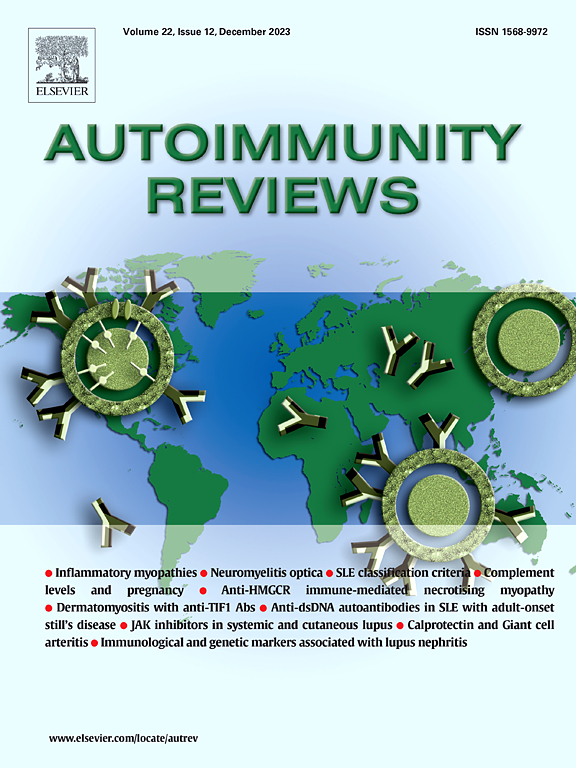炎症性肠病的全球患病率、残疾调整寿命年数和趋势及其与社会人口指数的相关性分析:1990 年至 2019 年的数据。
IF 9.2
1区 医学
Q1 IMMUNOLOGY
引用次数: 0
摘要
背景:炎症性肠病(IBD炎症性肠病(IBD)是一种慢性胃肠道炎症性疾病,在全球的发病率和发病模式各不相同。准确了解该疾病的流行病学特征对全世界的疾病控制和预防工作至关重要:利用 2019 年全球疾病负担(GBD)研究数据对 IBD 的全球负担进行最新估算,系统分析全球、地区和国家层面的 IBD 流行病学特征,包括流行率、发病率和残疾调整生命年(DALY)率,并分析社会经济发展水平与 IBD 流行病学特征的相关性:我们对 1990 年至 2019 年全球、地区和国家 IBD 负担进行了总体分析,数据来自 2019 年 GBD 研究。GBD 将全球划分为 21 个地区和 204 个国家和地区,这为全面分析提供了便利。通过计算年龄标准化估计年百分比变化(EAPCs)来评估 IBD 年龄标准化比率(ASRs)的时间趋势,同时采用年龄标准化来减轻年龄结构可能带来的混杂效应。社会人口指数(SDI)用于将社会经济发展水平与IBD的流行病学特征相关联:结果:从 1990 年到 2019 年,全球 IBD 的年龄标准化患病率、发病率和残疾调整寿命年率仍然居高不下。全球 IBD 年龄标准化发病率和残疾调整寿命率略有下降趋势,男性的残疾调整寿命率高于女性。2019年,高收入的北美洲的年龄标准化患病率、发病率和残疾调整寿命率最高,而大洋洲的年龄标准化患病率和发病率最低。南亚的年龄标准化残疾调整寿命年数率最低。年龄标准化死亡率和残疾调整寿命率随着 SDI 值的增加而下降,在过去三十年中一直高于预期水平。在国家层面,年龄标准化残疾调整寿命率与 SDI 之间呈负相关:对 GBD 2019 数据库的分析表明,全球 IBD 的总体负担仍然很高。结论:GBD 2019 数据库的分析表明,全球 IBD 的总体负担仍然很高。本文章由计算机程序翻译,如有差异,请以英文原文为准。

Analysis of global prevalence, DALY and trends of inflammatory bowel disease and their correlations with sociodemographic index: Data from 1990 to 2019
Background
Inflammatory bowel disease (IBD) is a kind of chronic inflammatory disorders of the gastrointestinal tract with diverse prevalence rates and patterns globally. Accurate comprehension of the disease's epidemiological characteristics is imperative for disease control and prevention all over the world.
Objective
To provide the most updated estimates on the global burden of IBD using the 2019 Global Burden of Disease (GBD) study data, to systematically analyze the IBD epidemiological characteristics at the global, regional, and national levels including the prevalence, incidence, and disability-adjusted life years (DALY) rates, and to analyze the correlations of the socioeconomic development level with IBD epidemiological characteristics.
Methods
We conducted an overall analysis of the global, regional, and national burden of IBD from 1990 to 2019, data from the 2019 GBD study. The GBD's classification of the world into 21 regions and 204 countries and territories facilitated a thorough examination. Age-standardized estimated annual percentage changes (EAPCs) were computed to assess the temporal trends in IBD age-standardized rates (ASRs), with age standardization employed to mitigate potential confounding effects from age structure. The sociodemographic Index (SDI) was used to correlate the socioeconomic development level with the epidemiological characteristics of IBD.
Results
From 1990 to 2019, the global age-standardized prevalence, incidence, and DALY rates of IBD remained high. There was a slight downward trend in the global age-standardized incidence and DALY rates of IBD and men exhibited higher DALY rates than women. In 2019, high-income North America recorded the highest age-standardized prevalence, incidence, and DALY rates, while Oceania had the lowest age-standardized prevalence and incidence rates. South Asia had the lowest age-standardized DALY rates. The age-standardized mortality and DALY rates decreased as SDI values increased and remained higher than the expected levels over the past three decades. A negative correlation was observed between age-standardized DALY rates and SDI at the national level.
Conclusions
This analysis of the GBD 2019 database demonstrates that the overall global burden of IBD is still high. Meanwhile, an increasing disease burden is observed in the middle and low SDI locations.
求助全文
通过发布文献求助,成功后即可免费获取论文全文。
去求助
来源期刊

Autoimmunity reviews
医学-免疫学
CiteScore
24.70
自引率
4.40%
发文量
164
审稿时长
21 days
期刊介绍:
Autoimmunity Reviews is a publication that features up-to-date, structured reviews on various topics in the field of autoimmunity. These reviews are written by renowned experts and include demonstrative illustrations and tables. Each article will have a clear "take-home" message for readers.
The selection of articles is primarily done by the Editors-in-Chief, based on recommendations from the international Editorial Board. The topics covered in the articles span all areas of autoimmunology, aiming to bridge the gap between basic and clinical sciences.
In terms of content, the contributions in basic sciences delve into the pathophysiology and mechanisms of autoimmune disorders, as well as genomics and proteomics. On the other hand, clinical contributions focus on diseases related to autoimmunity, novel therapies, and clinical associations.
Autoimmunity Reviews is internationally recognized, and its articles are indexed and abstracted in prestigious databases such as PubMed/Medline, Science Citation Index Expanded, Biosciences Information Services, and Chemical Abstracts.
 求助内容:
求助内容: 应助结果提醒方式:
应助结果提醒方式:


